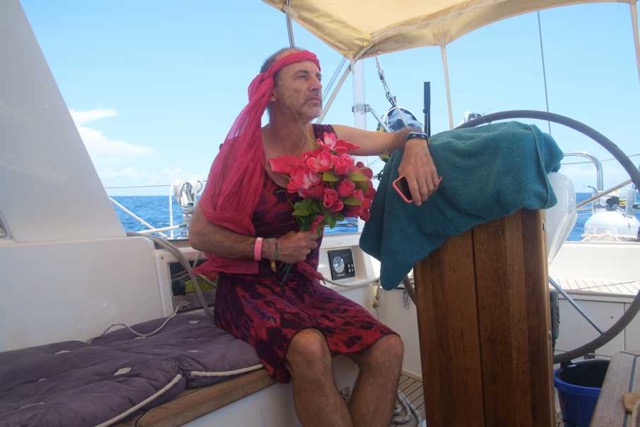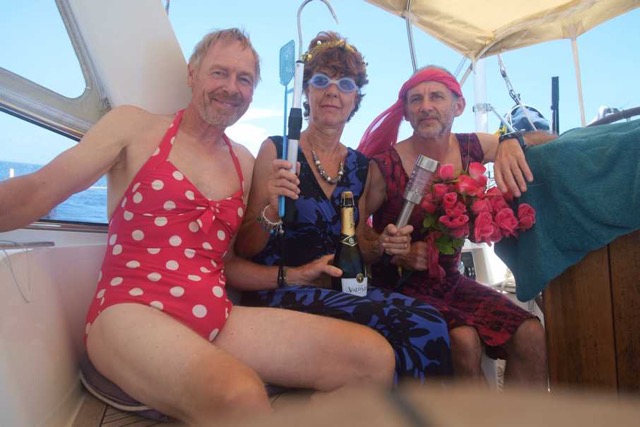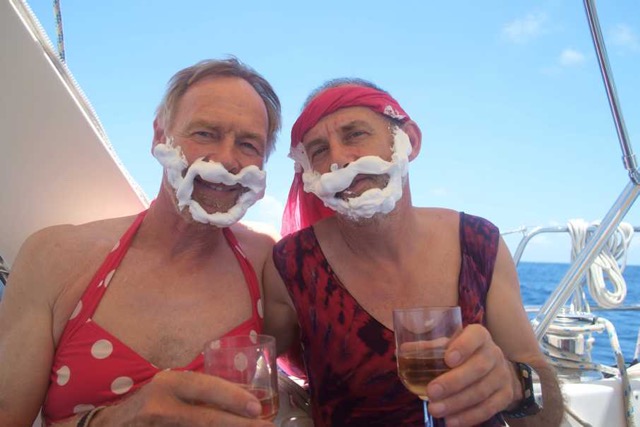Slimy Pollywogs and Trusty Shellback (aka Queen Neptune)

Vega
Hugh and Annie
Sat 18 Mar 2017 22:12
| 00:00.00N 88:00.00W This has been a momentous 24 hours. Yesterday our log recorded 10,000 nautical miles since we first sailed out of Kungsviken on Orust Island in Sweden with newly launched Vega. Then it was a beautiful sunny afternoon in May 2011 - just late enough in the year to ensure that the sea would not still be frozen as it had been when we went out to check on the build progress in February. Today the sun is shining just as brightly but the temperature is nearer to 30 degrees and at 1130 Ecuadorian time (1730 UT) we crossed the Equator. A bottle of bubbly was opened and enjoyed by the three crew, suitably dressed for the occasion. Tom and I were Slimy Pollywogs (a still used naval term to describe first time crossers of the Equator according to Wikipedia) and Annie was a Trusty Shellback having crossed in the Achille Lauro en route to Australia in 1969. As a previous crosser Annie was also Queen Neptune to sit in judgement of the sins carried out by the Slimy Pollywogs. These included demeaning the position of Captain by effecting sail alterations while wearing only underpants (guilty as charged) and being seen to dip his buttery knife in the honey jar (Tom the deckhand, now promoted to First Mate on condition this crime is never repeated). Annie’s crimes were to be too clever by half in memorising all the two letter scrabble words and failing to catch any fish on this trip. Punishment was the ritual humiliation of the miscreants and in time honoured tradition this involved shaving foam and cross dressing. Of course for Tom as a member of the Ambling Band this was normal practice and he felt quite at home. We have ongoing problems with the gas cylinders. The new larger cylinders are wider and with the regulator attached to the cylinder mean the gas pipe has to bend through 90 degrees for both cylinder and pipe to fit in the locker. To overcome this I bought a new regulator to be mounted away from the cylinder with the pipe feeding through a hole in the sidewall of the locker above the level of the cylinder (so that any leaking gas, being heavier than air, could still drain out of the bottom of the locker). Unfortunately none of the new connecting pipes will connect the new regulator to the boat’s pipework. This means that for the time being we have to use the existing regulator and connecting pipe, requiring a second hole in the side of the locker at the level of the regulator to avoid the 90 degree bend and crimp in the pipe that would inevitably lead to a split if left as it is. Not only this but we now cannot get a completely gas tight seal where the regulator screws into the steel cylinder we are currently using. It looks like there should be an O ring to effect a perfect seal - we are having to use thread sealant. The connections into the new aluminium cylinders look to have an internal O ring arrangement and the pipe connector between the tank and the new regulator also has a much better shape and O ring also. However, unless and until we can connect the new regulator to the boat gas pipe we will still have to use the old regulator and pray that this fits properly into the aluminium tanks without leaking……………… Most the the day yesterday was taken up with trying to solve this problem - hence no blog. If the passage between Panama and Galápagos we are experiencing is typical of Pacific passages to come then things are looking promising! The wind is blowing a more or less steady 10 to 15 knots form the north east, the sun is shining and a 2.5kt current is wafting us along also. At the moment we are under bare poles trying to slow down to avoid arriving in the middle of the night. Unfortunately we are still making 4kts - now we know how the rowing boats do it! Of course our conditions are by no means typical and it can be notoriously difficult finding an easterly (or any) wind in the Doldrums. One option is to head south along the Ecuador coast to pick up easterly trade winds further south. Still, our luck is in at the moment and tomorrow morning we should be fending off the sealions from basking on our swim platform in San Cristobal. Before we left England we read that the radar would come into its own picking up tropical squalls and giving either forewarning or the chance to avoid them. This has been the case on this leg and we have neatly woven our way between some pretty hefty looking downpours with bright lightning flashes throughout each night. The combination of radar, AIS and plotter gives an amazing amount of information to navigate by and we are learning new sources of information almost every day. We (Annie) have just discovered that you can lock onto a radar target and see from a vector line in which direction the target is moving relative to our vessel. Off now to change into something a little more manly and wash off all that foam.    |